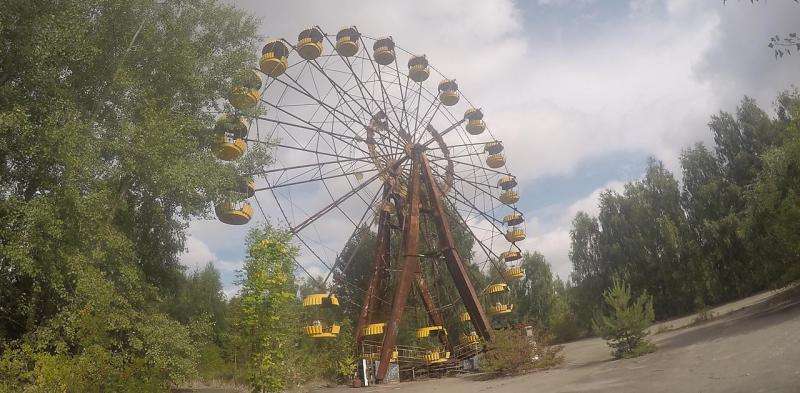The legacy of Chernobyl—30 years on

The 26 April 2016 marks the 30th anniversary of the Chernobyl nuclear accident.
For many, especially those born since 1986, it is a word they know without appreciating the full significance of what happened on that day. For others, it was a life changing catastrophe which resulted in largest release of radioactivity in the history of nuclear energy.
After an explosion and fire at the Chernobyl nuclear reactor in northern Ukraine, the release of fuel particles composed of uranium oxides and other radionuclides affected areas across the former Soviet Union (Ukraine, Belarus and Russia), also spreading to other parts of Europe.
Between 27 April and 6 May, the entire population of the Pripyat township – about 44,000 people – was evacuated, with a 30km exclusion zone placed around the accident site. Overall, an area inhibited by six million people in the former Soviet Union was officially designated as 'contaminated', and about five million still live in areas with elevated levels of radioactive deposition – approximately half of those are in strictly controlled zones (SCZs).
When the accident happened, the 'iron curtain' was down and we only learned about it when the radioactivity was detected by Scandinavian countries. Many believe the accident and the associated economic impact, which over the decades has been estimated to be in hundreds of billions US dollars, acted as a catalyst for the 'Glasnost' movement, leading to dissolution of the Soviet Union.
The accident did stimulate many international collaborations, laws, treaties and conventions, but these have proved not to be strong enough to enable international organisations to immediately and independently intervene and overview accident situations. This was evident in Japan five years ago when the world had to wait for weeks to know the precise impact of a tsunami on the nuclear reactor at Fukushima.
Since April 1986, a huge amount of resources have been spent on research to assess the lasting consequences of the accident on our health, and advancing technologies for nuclear safety.
Ionising radiations are known to induce genetic mutations, which can be passed down the generations, and in the body these cells can lead to cancer development. But apart from higher incidence of thyroid cancers in the exposed population, any increases in other cancers are yet to be fully established with figures from the World Health Organisation (WHO) – estimating up to 5,000 additional cancers – being contested by other organisations.
However, there are potentially other health implications including higher incidence of cataracts, cardiovascular diseases, and congenital abnormalities, in addition to mental and psychological effects. These potential health legacies will need to be fully established in years to come.
At the height of the Cold War, there was high profile research in the field of radiobiology and radioecology, but this gradually declined in late 1970s and early 1980s as funding sources started to shrink. The Chernobyl accident led to a resurgence in these studies, aiming to aid the remediation process and make future predictions on post-accident situations. Based on these studies, it is envisaged that remediation measures will be required in inhabited areas for the foreseeable future, such as restrictions on animal production, including in some Scandinavian countries.
Most of these studies also provide models describing the impact of soil types on radionuclide transfer into the food-chain via fruits, vegetables, milk and meat, giving an estimation of the potential radiation doses to affected populations.
One of the topics still being fiercely debated is the potential impact of radiation on wildlife, because while the impact on certain trees was evident, deciduous trees were more resistant.
The region's radioactivity levels are falling but the impacted areas still contain a large proportion of long-lived radionuclides within the soil, forests and wetlands. Future forest fires and floods are likely to aggravate the situation.
More integrated studies with laboratory validation experiments incorporating robust study plans, eliminating potential confounding factors and biased experimental designs are required to shed lights on the potential impact on the biota.
Public opinion regarding the use of nuclear power is gradually changing.
Younger generations see the use of nuclear power differently from those who experienced the fears of 'cold war' and 'mushroom clouds', and nuclear energy is also seen as a potential mitigator of global warming resulting from fossil fuel burning.
To boost public confidence and to ensure the 435 operational units and 63 proposed reactors around the world run safely, operators and regulators need to set up comprehensive, mutually agreed and transparent plans.
The nuclear industry also faces challenges regarding the storage and repository of the generated waste, as well as the remediation of historic legacy and managing radioactive discharges, and regulators need to assess the safety, security and environmental implications of new designs before they are built. This should resolve the majority of health, social and economic implications.
The accident at Chernobyl has had huge environmental, socio-economic and political consequences, and while we have learned many lessons, our final thought should perhaps be about human values and the role of firefighters, liquidators, plant workers and the affected families. Today is an opportunity to remember them and pay tribute.
Provided by University of Plymouth




















